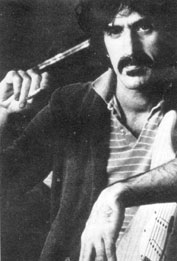Cover Art
March 13, 1981—John Livzey Photo Session

John Livzey, interviewed by Tom Brown, April-May 2002
I got this job from an art director friend, Dave Schroer, who had a client who manufactured the Acoustic amps. And the idea was to get a shot of Frank with the amp because he was endorsing it. So we went to his house up in the Hollywood hills. He had a cool house, very cozy. And he had just finished putting the recording studio in. It was brand new; it smelled brand new. And off to the side he had an echo chamber. It was a separate room, all white with rounded corners. And he had a beautiful Steinway piano with a whole extra octave of black keys. [...] I thought we'll have Frank standing behind this amp, and I'll get down low and shoot up into the ceiling. Thomas Nordegg was there; I think there were a bunch of people around. Frank came in the room finally and he was multi-colored, wearing turquoise, with a peach t-shirt, a chartreuse jacket and he had on baggy trousers and tennis shoes that were three or four different colors. He was pretty wildly dressed and his hair was all tousled.
[...] I told him briefly what we were going to do and he said "Yeah, yeah. Okay" and he left for a few minutes before coming back in. I was nervous about shooting him, since I wasn't used to shooting well-known people, and he made me nervous anyway. I remember saying to all the gathered crew there "When he comes out and we start shooting, I'm not a prima donna about this and if anybody wants to talk or interject, or suggest, I have no problem with that." In other words, help me out! [...] He came in the room and I was crouched down behind the camera and everybody just melded into the shadows . . . nobody said anything. [...] So Frank comes out and I shot a Polaroid and then its two minutes that it has to cook, and those two minutes can be excruciating when everybody has melded into the shadows, and it's just you and Frank. And I don't know Frank and he doesn't know me, and he's not particularly talkative.
[...] The idea was to try to make it look like he was on stage, and I think he said something like "Well, no one's really going to believe that," and I said "You're right. They're not really going to believe it, but for being in here I think it sort of conveys the idea." There were a couple of little lights high above him. Party jells over them would have made it more realistic you know, but it sort of worked. And he said "Okay, do it." So I get down behind the camera and he's got the guitar on and he's glaring at me with that Zappa look, and I said "Why don't you play us a tune?" and he says, in a very slow deadpan "I don't play tunes." I'll never forget that. Dead silence. And everybody in the shadows went FURTHER into the shadows. They became the shadows. But somehow I got through the shoot, I don't know how.
[...] But here's what happened. We did the shoot and I shot a few rolls, and it was "Thank you very much," and everybody came back out of the shadows, and handshakes all around, a lot of frivolity and everybody's happy. So Frank says "You got any black and white film?" and I said "Yeah," and he said "Why don't you shoot a couple of rolls of me?" And I think I hesitated. I'm not sure what I said or what I did, but I remember it being a little awkward, and he said "No, listen, if I like them, I'll buy them from you. I'm not trying to take advantage of you." I'm not sure how he actually said it, but he assured me that he wasn't trying to rip me off. I said "Yeah, okay," so everybody left. All the shadow people were pretty much gone except my assistant, who was a guy I didn't know. His name was Chris, and I don't think I had ever worked with him before. So I took these pictures of Frank at home, and that was the day I met him. [...] March 13, 1981. [...] So I sent the pictures to him a couple of days later and a couple of days after that the phone rang and I picked it up, and he said "Livzey?" and I said "Yeah," and he says "Zappa." I said "Hey Frank, how are you doing?" I remember I was really surprised. It wasn't Frank's people calling, it was Frank on the phone, and basically what he said was he liked the pictures. [...] So Frank ordered several 16" by 20" prints. He ordered full frame pictures of about ten different images. A bunch of pictures and he loved them all. [...] He used this [on the record sleeves of the Shut Up 'N Play Yer Guitar LP box].
April 7, 1981—John Livzey Photo Session
John Livzey, johnlivzey.com
Frank Zappa in an outtake from an album called Shut Up 'N Play Yer Guitar.
John Livzey, interviewed by Tom Brown, April-May 2002
Frank at home, April 7, 1981; that's when we had the all-night session. That was probably the best session I had with him. The pictures that came from that were "Shut Up and Play Your Guitar," the cover, and well, just one picture came out of it really, but from my point of view it was just a good session, it was fun. We were there all night long.
